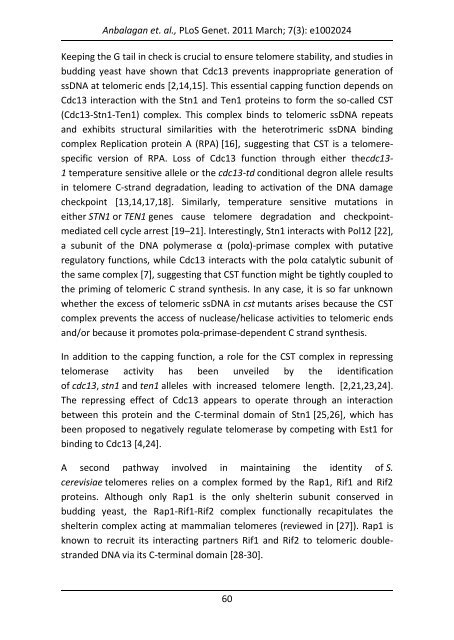View/Open - Università degli Studi di Milano-Bicocca
View/Open - Università degli Studi di Milano-Bicocca
View/Open - Università degli Studi di Milano-Bicocca
Create successful ePaper yourself
Turn your PDF publications into a flip-book with our unique Google optimized e-Paper software.
Anbalagan et. al., PLoS Genet. 2011 March; 7(3): e1002024<br />
Keeping the G tail in check is crucial to ensure telomere stability, and stu<strong>di</strong>es in<br />
bud<strong>di</strong>ng yeast have shown that Cdc13 prevents inappropriate generation of<br />
ssDNA at telomeric ends [2,14,15]. This essential capping function depends on<br />
Cdc13 interaction with the Stn1 and Ten1 proteins to form the so-called CST<br />
(Cdc13-Stn1-Ten1) complex. This complex binds to telomeric ssDNA repeats<br />
and exhibits structural similarities with the heterotrimeric ssDNA bin<strong>di</strong>ng<br />
complex Replication protein A (RPA) [16], suggesting that CST is a telomerespecific<br />
version of RPA. Loss of Cdc13 function through either thecdc13-<br />
1 temperature sensitive allele or the cdc13-td con<strong>di</strong>tional degron allele results<br />
in telomere C-strand degradation, lea<strong>di</strong>ng to activation of the DNA damage<br />
checkpoint [13,14,17,18]. Similarly, temperature sensitive mutations in<br />
either STN1 or TEN1 genes cause telomere degradation and checkpointme<strong>di</strong>ated<br />
cell cycle arrest [19–21]. Interestingly, Stn1 interacts with Pol12 [22],<br />
a subunit of the DNA polymerase α (polα)-primase complex with putative<br />
regulatory functions, while Cdc13 interacts with the polα catalytic subunit of<br />
the same complex [7], suggesting that CST function might be tightly coupled to<br />
the priming of telomeric C strand synthesis. In any case, it is so far unknown<br />
whether the excess of telomeric ssDNA in cst mutants arises because the CST<br />
complex prevents the access of nuclease/helicase activities to telomeric ends<br />
and/or because it promotes polα-primase-dependent C strand synthesis.<br />
In ad<strong>di</strong>tion to the capping function, a role for the CST complex in repressing<br />
telomerase activity has been unveiled by the identification<br />
of cdc13, stn1 and ten1 alleles with increased telomere length. [2,21,23,24].<br />
The repressing effect of Cdc13 appears to operate through an interaction<br />
between this protein and the C-terminal domain of Stn1 [25,26], which has<br />
been proposed to negatively regulate telomerase by competing with Est1 for<br />
bin<strong>di</strong>ng to Cdc13 [4,24].<br />
A second pathway involved in maintaining the identity of S.<br />
cerevisiae telomeres relies on a complex formed by the Rap1, Rif1 and Rif2<br />
proteins. Although only Rap1 is the only shelterin subunit conserved in<br />
bud<strong>di</strong>ng yeast, the Rap1-Rif1-Rif2 complex functionally recapitulates the<br />
shelterin complex acting at mammalian telomeres (reviewed in [27]). Rap1 is<br />
known to recruit its interacting partners Rif1 and Rif2 to telomeric doublestranded<br />
DNA via its C-terminal domain [28-30].<br />
60

















